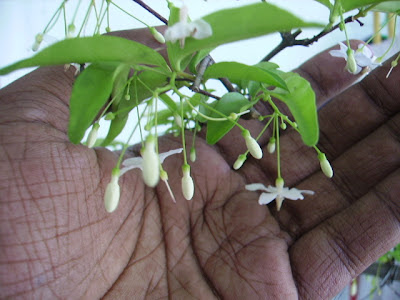
My ferns in the hanging pots had partially dried and I had hanged it in a unreachable place as to maximise my garden space. Along with others those which are not so attractive plants hidden at the background where it serves as a haven for snails, slugs and mealy bugs.
I was thinking... and thinking...
Should I or shouldn't I?
It was really a now or later issue actually...
And so these thoughts continued playing in my mind as I was pruning & cutting off all the dried fern pots after another. Most of the Maiden Hair Ferns and the Fluffy Ruffle Ferns are dried at the bottom (either too hot and had faced lack of water)
The Cane Begonia had grown nicely about to my height and I had also pruned it to give a nice lovely look.

.
Above all I cannot stop admiring the Spiral Ginger with the Never plant together with the Dumbcane plants - they give the everlasting variegated white look.
.
With the Green Flaming Violet and the blue tiles at the foreground certainly gave a nice feature to feast the eye upon. (With the background of the begonias and the red vine plant)
.

.
Back: ZigZag plant, Black Berry Lily, Creeping Fig
Front: in the planter box - Song of India & (another one which I had forgotten its name)
.
The sore eye begins with all the half eaten leaves in all of these plants. These are all been damaged by slugs and snails which seemed to be hiding behind all these stones.
.
The only way to get rid of them is to remove these and properly clean the whole area.
(This is what I was contemplation on: Should I or Shouldn't I)
.

.
I started this with a small handful strings from my mother's garden.
.
Eventually I had nurtured it and made many hangers, currently there are 3 here. I had given a lot of it as gifts to my neighbours and also to my mum but unfortunately none of them survived in their garden. (sob..sob..)
.
Currently this Spanish Moss do take the limelight of my garden. I think I had seen too much of it that it totally block most of the lovely view of my garden. Or perhaps another word - too long & messy.
.

.
(Hibiscus, Water Jasmine, Bougainvillea)
.
The hibiscus have been flowering a lot lately, but the rest of it is just foliage - too many and leggy actually. It had altogether had turned the whole garden very heavy looking.
.

.
(Bleeding Hearts, Palm Orchid, Maiden Hair Fern)
.
These were infected with whitefly and were farmed by ants. It didn't do any damage to the plants. I didn't want to resort to pesticide too soon so I just managed by flushing them with water. I know its a losing battle as these pest might just multiply within a weeks time. Probably will check on them on the coming weekend to see how bad is bad.
.

































































